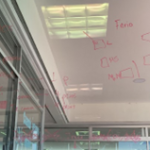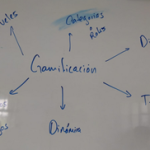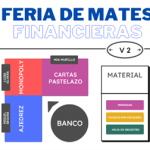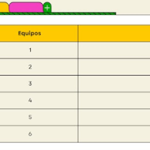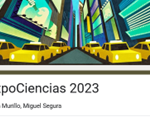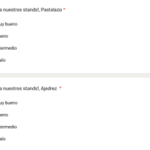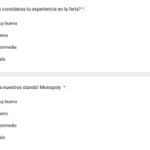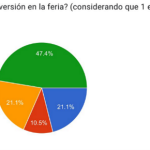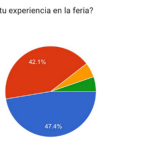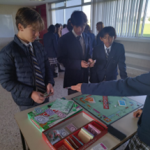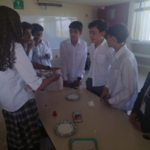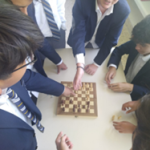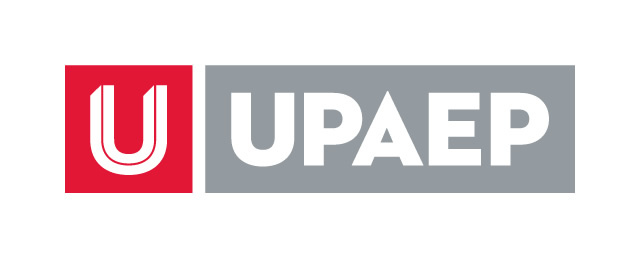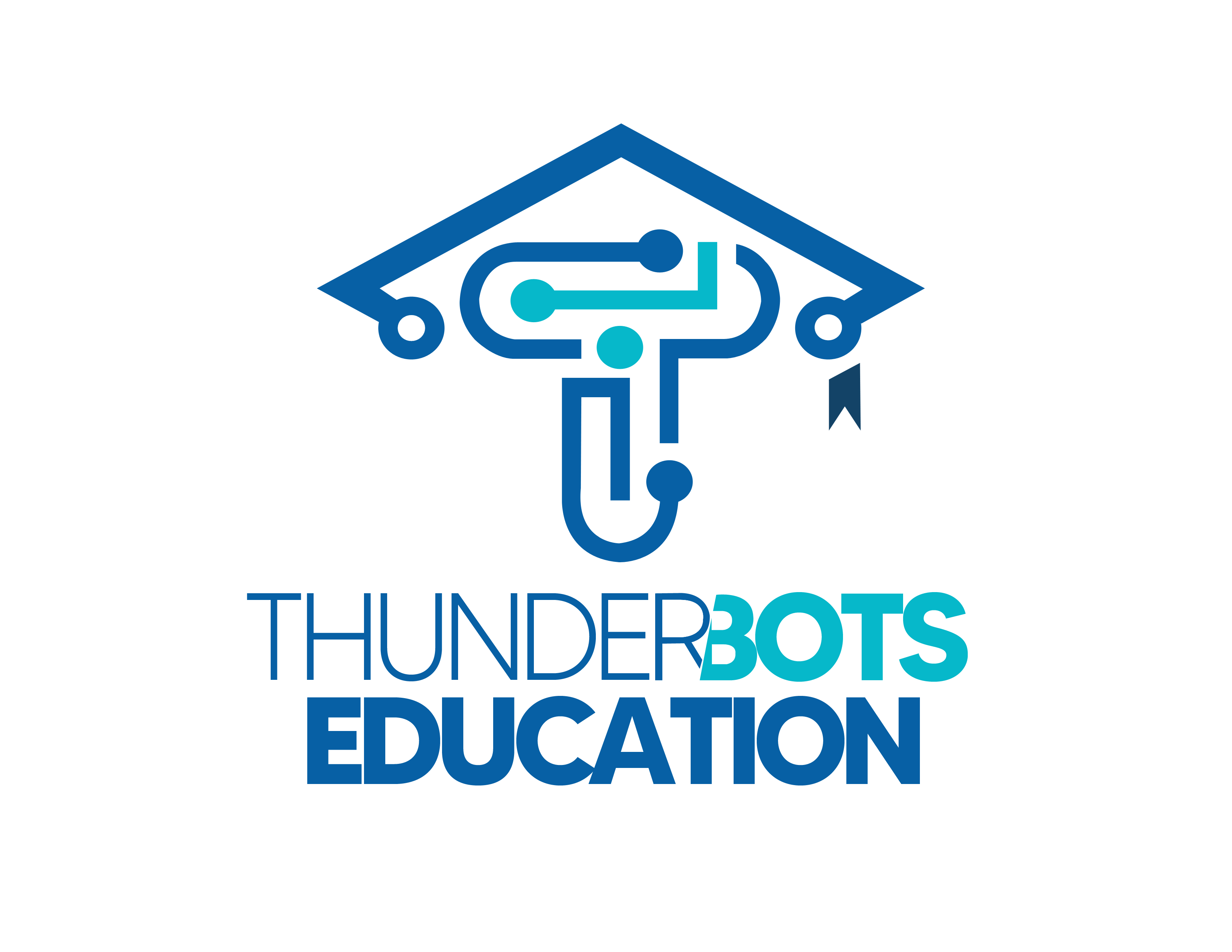PJ – DC – 63 Feria de Matemáticas Financieras
PJ – DC – 63 Feria de Matemáticas Financieras
Categoría: Pandilla Juvenil (1ro. 2do. y 3ro. de nivel Secundaria)
Área de participación: Divulgación y enseñanza de la ciencia
Resumen
El desarrollo de la Inteligencia Financiera en edades desde los 6 años hasta los 15 años parte importante en el desarrollo y crecimiento para enfrentar al mundo, viendo que vivimos en una sociedad dominada por el movimiento de la economía y el manejo del dinero, sin disminuir la importancia en los demás elementos que llevan a una persona a su completa integridad. La inteligencia financiera se conoce como la capacidad de crear y desarrollar diferentes fuentes de ingreso. Es necesario que nosotros como adolescentes podamos dominar las matemáticas en finanzas para tener un mejor desarrollo para nuestro futuro; por esta razón creamos una feria de matemáticas, ya que sabemos que esta materia es difícil para algunos de nuestros compañeros, incluso llegar a ser aburrida, por eso mediante juegos, música, premios y dinámicas creemos que nuestros compañeros puedan aprender mejor y desarrollar su inteligencia financiera. Por lo tanto, este proyecto va a describir una forma de cómo se puede usar la técnica de la Gamificación, técnica de aprendizaje que traslada la mecánica de los juegos al ámbito educativo-profesional con el fin de conseguir mejores resultados. A través de retos, actividades, aumento de niveles y categorías nuestros compañeros desarrollarán su inteligencia financiera, dependiendo del carácter, gustos y habilidades que ya posee, utilizando juegos de mesa, dinámicas y sistema de feria. En donde se van a ver temas cómo administración del tiempo, presupuesto, ingreso pasivo, ventas, ahorro, estrategia financiera, inversiones, patrimonio, entre otros.
Pregunta de Investigación
Entre los alumnos de 6 a 15 años, ¿Pueden entender mejor las Matemáticas utilizando un sistema divertido y dinámico diseñado por estudiantes para estudiantes en comparación con el sistema tradicional, utilizando el tema de Finanzas?Planteamiento del Problema
Se tienen dos problemas importantes que se van a enfrentar en este proyecto, la dificultad de la asignatura de Matemáticas y la falta del desarrollo de la inteligencia financiera en las personas. La asignatura de Matemáticas generalmente ha sido complicada para las personas en aprender, por su parte lógica-matemática y por el tipo de problemas que se generan dentro del salón de clases; así como el aburrimiento que causa en algunas personas. Y el segundo problema, la falta de Inteligencia Financiera, vivimos en un país en donde se basa principalmente en el conocimiento y manejo del dinero, y si las personas no lo conocemos es muy complicado que se tenga una buena calidad de vida.
Antecedentes
De acuerdo a nuestras investigaciones, el MIDE (Museo Interactivo de Economía) tiene talleres, expos, cursos y maestrías sobre el desarrollo de la Educación Financiera, para que los adolescentes, como nosotros, conozcamos temas diversos de finanzas y economía como deuda, problemas financieros, finanzas internacionales para niños, etc.
También existen diferentes sistemas para niños y adolescentes, como tipo KUMON (Sistema para aprender Matemáticas) pero para negocios y finanzas, como son My Business Kids, en donde se enseñan desde cero cómo empezar un negocio, entre otros. Así como cursos en diferentes partes de la República. Pero se basan principalmente en Educar más no en desarrollar, solo en conocer, pero poco en practicar.
Objetivo
Ayudar a los alumnos de 6 a 15 años a entender mejor la materia de Matemáticas con una feria especializada y desarrollar su inteligencia financiera para que aprendan a controlar el dinero.
Justificación
Nos dimos cuenta que los cursos, sistemas y talleres que se han creado solo se enfocan en la Educación Financiera pero no en la práctica, así como las matemáticas son difíciles de aprender para algunos de los adolescentes; de acuerdo a un análisis que hizo Kumon en México, solo 2 de cada 10 niños mexicanos que cursan la primaria y secundaria cuentan con una preparación escolar suficiente en matemáticas; por lo tanto si diseñamos un sistema en donde cualquier alumno quiera y pueda aprender de una manera más fácil la asignatura, agregando un tema interesante y que tenga una función en su vida futura, que es el dinero, podemos llegar directamente al inconsciente de los adolescentes. Se quiere aplicar a diferentes escuelas, de diferentes partes del Estado para poder ver la reacción y el aprendizaje de cada grupo de alumnos dependiendo del lugar.
Hipótesis
Si problemas matemáticos financieros para nivel secundaria se enseñan de una manera dinámica y divertida, entonces los alumnos van a aprender más rápido y desarrollar la forma en como pueden controlar su dinero.
Método (materiales y procedimiento)
Se utilizó el Sistema de Gamificación junto con el Método Científico, esto fue por los principales puntos que queremos comprobar; que sea divertido pero que sea un proyecto de investigación, por lo tanto, lo debemos de hacer a prueba y error, realizando varias pruebas y realizando encuestas para analizar lo que aprendieron los alumnos y si realmente fue divertido con aprendizaje.
Por los requerimientos de ExpoCiencias Estado de México 2023 solo se instalaron 3 estaciones por la cantidad de miembros del equipo, pero también tuvimos compañeros de apoyo que sirvieron para poder controlar mejor a los alumnos. El profesor Carlos nos apoyó con el banco y explicando la dinámica de cómo funcionaría a los alumnos.
Se realizaron varios modelos y diseños antes de realizar el primer prototipo de feria, ya que en equipo tratábamos de decidir cuales serían la mejor opción, este trabajo lo realizábamos en el laboratorio de pruebas del colegio.
Era muy importante saber que tipo de juegos y dinámicas íbamos a usar, se nos ocurrieron varias formas de realizarlo, pero había muchas variables, muchas cosas que se nos salían de nuestro control, cómo el tiempo entre cada estación, si un equipo de alumnos terminaba tenían que esperarse para ir a otra estación, las reglas del juego eran complicadas de entender o aburridas, las mesas estaban muy juntas, aparte de diseñar el sistema de gamificación. Lo que no queríamos era que se pareciera a un rally escolar, sino algo diferente y entretenido. Es muy importante que de acuerdo a la Gamificación se tenga que realizar dinámicas de competencia, así como de crecimiento.
Al final llegamos a la conclusión de qué se utilizarían 4 estaciones con las siguientes dinámicas y juegos, recordando que este se va a estar mejorando dependiendo de las ferias que se vayan realizando.
- Estación de Monopoly: en esta estación se va a trabajar con el manejo del dinero, el ahorro y la compra y venta.
- Estación de Ajedrez: en esta estación se va a trabajar la estrategia, la inteligencia financiera, en donde por medio de diferentes métodos y estrategias se puede obtener un resultado, el Ajedrez se va a utilizar con un sistema de ganancias y pérdidas. Se invierte cada vez que se juega.
- Estación de cartas con preguntas: en esta estación se va a trabajar los cálculos matemáticos, por medio de una serie de preguntas se va a retar a los alumnos, por equipo, para que respondan si no responden se van a tener un castigo.
Banco: en este lugar se pueden intercambiar monedas y billetes en donde se generan deudas para los equipos y se determinan a los ganadores.
El sistema que utilizamos para que la feria funcionará con la gamificación fue la siguiente:
- Se van a dividir a los alumnos o concursantes en 6 equipos de 3 a 4 personas.
- Posteriormente se les hace la explicación de cómo va a funcionar la feria, esta explicación debe de ser dinámica y divertida desde el principio, si la dinámica empieza de una forma aburrida es una mala imagen que se da.
- Se pasa al banco, en donde el profesor les explica como funciona el canje de las monedas.
- Al inicio de la feria, el banco les dará a cada equipo una moneda, esta moneda sirve para entrar a una estación, la que ellos elijan, pero solamente se puede entrar con una moneda.
- Una vez que terminen la dinámica de su estación, dependiendo de si ganaron o perdieron a los equipos se les dan tickets. Con esos tickets pueden comprar más monedas para pasar a otra estación.
- Cada moneda cuesta 3 tickets, si en dado caso de que el equipo no tenga los tickets suficientes para comprar la moneda, entonces el banco le presta una moneda, pero con el interés de 1 ticket, es decir, que al banco le tendrán que pagar 4 tickets por cada moneda prestada.
- Al final el equipo que tenga más tickets y menos deudas gana la dinámica.
- La dinámica de la feria dura 30 minutos.
- Se agregó música y un espacio en específico para la feria, la música fue seleccionada para que sea divertida pero que se puedan concentrar.
- Al final a los equipos se les clasifica de acuerdo a los tickets y deudas que tienen, se clasifican en tres tipos.
Los materiales que utilizamos fueron los siguientes: juego de mesa Monopoly, ajedrez de madera, cartas de plástico UNO, platos desechables, crema pastelera, 200 monedas de madera, 1000 tickets con características especificas dependiendo de la estación en la que se encuentren, 3 mesas, 3 sillas, formatos para anotar a los ganadores, deudores y perdedores, preguntas y respuestas de la dinámica del pastelazo.
Tratamos de utilizar materiales que ya teníamos a la mano, para no gastar tanto, nos enfocamos principalmente en el diseño de la feria, que sea dinámico y que realmente aprendieran los alumnos. Una feria con tres estaciones, con todo el material sería de aproximadamente 2400 pesos, pero como los tickets y monedas se pueden hacer en papel entonces se podría obtener más barato.
Resultados
Cuando realizamos la última feria dentro del Colegio realizamos una encuesta en Google Forms en donde nos pudo mostrar resultados importantes para mejorar la próxima feria, que ya está programada para realizarla con los alumnos de sexto y quinto de primaria, para poder medir y mejorar la feria, ya que son diferentes dinámicas para secundaria y para primaria.
De acuerdo a las gráficas anteriores, que tomamos de las dos preguntas que suponemos son las más importantes, podemos encontrar dos puntos interesantes, el primero es que más de la mitad de los alumnos encuestados encontraron que muy buena y buena en cuanto a experiencia en la feria, con un porcentaje muy bajo de mala experiencia; pero el segundo podemos ver que hubo un porcentaje de 21%, casi una quinta parte que no se divirtió en la feria, esto nos ayuda a ver que la diversión y la experiencia lo toman como formas diferentes.
Discusión
En cuanto a la última pregunta nos dieron su opinión sobre la falta de dinámicas o que fueran diferentes dinámicas para la feria, algunos nos dijeron que pusiéramos otra dinámica en lugar del ajedrez, se les hizo un poco aburrida ya que todos no sabían jugarlo.
Estos datos y comentarios nos ayudan a mejorar la feria, agregar una nueva dinámica con matemáticas en lugar del ajedrez, y enfocarnos en que la experiencia y la diversión vayan de la mano.
También nos dimos cuenta que los alumnos les faltaban más temas sobre estadísticas y finanzas, aún no han dominado los temas básicos.
Conclusiones
Pudimos ver que una feria tiene gran potencial para enseñar Matemáticas Financieras, es muy divertida y se pueden diseñar varias formas de hacer dinámicas. También pudimos encontrar que el diseño de la feria no es sencillo, medir los tiempos, controlar a los alumnos, encontrar el diseño de cada dinámica, y tener los temas adecuados para la enseñanza es algo complicado.
También encontramos que en una feria se pueden hacer muchas investigaciones y encontrar muchos resultados diferentes, ya que, por cada grado, la madurez y diversión de los alumnos es diferente, por lo tanto las dinámicas deben ser diferentes para que puedan aprender, además de la falta de los conocimientos básicos de matemáticas.
Bibliografía
- Edición. (2020, March 17). Inicio. Actualidad en Psicología. https://www.actualidadenpsicologia.com/
- Kapp, K. (2012). The Gamification of Learning and Instruction. Game-based methods and Strategies for Training and Education. Pfieffer
- J. Grinder – R. Bandler (1979). De Sapos a Príncipes. PNL una obra esencial de Programación Neurolingüistica.
PJ – DC – 63 Feria de Matemáticas Financieras
PJ – DC – 63 Feria de Matemáticas Financieras
Summary
The development of Financial Intelligence in ages from 6 years old to 15 years old is an important part in the development and growth to face the world, seeing that we live in a society dominated by the movement of the economy and money management, without diminishing the importance of the other elements that lead a person to his or her complete integrity. Financial intelligence is known as the ability to create and develop different sources of income. It is necessary that we as teenagers can master mathematics in finance to have a better development for our future; for this reason we created a math fair, as we know that this subject is difficult for some of our peers, even become boring, so through games, music, prizes and dynamics we believe that our peers can learn better and develop their financial intelligence. Therefore, this project will describe a way to use the Gamification technique, a learning technique that transfers the mechanics of games to the educational-professional field in order to achieve better results. Through challenges, activities, increasing levels and categories, our colleagues will develop their financial intelligence, depending on the character, tastes and skills they already have, using board games, dynamics and fair system. We will cover topics such as time management, budgeting, passive income, sales, savings, financial strategy, investments, equity, among others.
Research Question
Among students aged 6 to 15, can they better understand Mathematics using a fun and dynamic system designed by students for students compared to the traditional system, using the topic of Finance?Problem approach
There are two important problems that will be faced in this project, the difficulty of the subject of Mathematics and the lack of development of financial intelligence in people. The subject of Mathematics has generally been complicated for people to learn, because of its logical-mathematical part and the type of problems that are generated in the classroom, as well as the boredom it causes in some people. And the second problem, the lack of Financial Intelligence, we live in a country where it is based mainly on the knowledge and management of money, and if people do not know it is very difficult to have a good quality of life.
Background
According to our research, the MIDE (Interactive Museum of Economics) has workshops, expos, courses and master’s degrees on the development of Financial Education, so that teenagers, like us, can learn about different topics of finance and economics such as debt, financial problems, international finance for children, etc.
There are also different systems for children and teenagers, such as KUMON (Mathematics Learning System) but for business and finance, such as My Business Kids, where they teach from scratch how to start a business, among others. As well as courses in different parts of the Republic. But they are mainly based on educating rather than developing, only on knowing, but little on practicing.
Objective
To help students from 6 to 15 years old to better understand the subject of Mathematics with a specialized fair and to develop their financial intelligence so that they learn to control their money.
Justification
We realized that the courses, systems and workshops that have been created only focus on Financial Education but not in practice, just as mathematics is difficult to learn for some teenagers; according to an analysis made by Kumon in Mexico, only 2 out of 10 Mexican children in primary and secondary school have sufficient school preparation in mathematics; Therefore, if we design a system where any student wants and can learn the subject in an easier way, adding an interesting topic that has a function in their future life, which is money, we can directly reach the unconscious of adolescents. We want to apply it to different schools in different parts of the state to be able to see the reaction and learning of each group of students depending on the place.
Hypothesis
If high school financial math problems are taught in a dynamic and fun way, then students will learn faster and develop the way they can control their money.
Method (materials and procedure)
The Gamification System was used together with the Scientific Method, this was for the main points that we want to check; that it is fun but that it is a research project, therefore, we must make it trial and error, performing several tests and conducting surveys to analyze what the students learned and if it was really fun with learning.
Due to the requirements of ExpoCiencias Estado de México 2023, only 3 stations were installed due to the number of team members, but we also had support colleagues who helped us to better control the students. Professor Carlos helped us with the bench and explained the dynamics of how it would work to the students.
Several models and designs were made before making the first prototype fair, as a team we tried to decide which would be the best option, this work was done in the testing laboratory of the school.
It was very important to know what kind of games and dynamics we were going to use, we came up with several ways to do it, but there were many variables, many things that were out of our control, such as the time between each station, if a team of students finished they had to wait to go to another station, the rules of the game were complicated to understand or boring, the tables were very close together, apart from designing the gamification system. We didn’t want it to look like a school rally, but something different and entertaining. It is very important that according to the Gamification it is necessary to carry out competition dynamics, as well as growth.
In the end we came to the conclusion that 4 stations would be used with the following dynamics and games, remembering that this will be improved depending on the fairs that will be held.
- Monopoly Station: in this station we will work with money management, saving and buying and selling.
- Chess Station: in this station we will work on strategy, financial intelligence, where by means of different methods and strategies we can obtain a result, Chess will be used with a profit and loss system. It is invested every time it is played.
- Station of cards with questions: in this station we will work on mathematical calculations, by means of a series of questions we will challenge the students, by team, to answer if they do not answer, they will be punished.
- Bank: in this place coins and bills can be exchanged where debts are generated for the teams and the winners are determined.
The system we used to make the fair work with gamification was as follows:
- The students or contestants are divided into 6 teams of 3 to 4 people.
- Afterwards they are given an explanation of how the fair will work, this explanation must be dynamic and fun from the beginning, if the dynamic starts in a boring way it is a bad image that is given.
- They go to the bank, where the teacher explains how the exchange of coins works.
- At the beginning of the fair, the bank will give each team a coin, this coin is used to enter a station, the one they choose, but you can only enter with a coin.
- Once they finish the dynamics of their station, depending on whether they won or lost the teams are given tickets. With those tickets they can buy more coins to move to another station.
Each coin costs 3 tickets, if the team does not have enough tickets to buy the coin, then the bank will lend them a coin, but with the interest of 1 ticket, that is, they will have to pay the bank 4 tickets for each coin lent. - At the end the team that has more tickets and less debts wins the dynamic.
- The dynamics of the fair lasts 30 minutes.
- We added music and a specific space for the fair, the music was selected to be fun but to be able to concentrate.
- At the end the teams are classified according to the tickets and debts they have, they are classified in three types.
The materials we used were the following: Monopoly board game, wooden chess, UNO plastic cards, disposable plates, pastry cream, 200 wooden coins, 1000 tickets with specific characteristics depending on the season in which they are found, 3 tables, 3 chairs, forms to record the winners, debtors and losers, questions and answers of the dynamics of the pastelazo.
We tried to use materials that we already had on hand, so as not to spend so much, we focused mainly on the design of the fair, that it would be dynamic and that the students would really learn. A fair with three stations, with all the material would be approximately 2400 pesos, but since the tickets and coins can be made on paper then it could be obtained cheaper.
Results
When we conducted the last fair within the school we conducted a survey in Google Forms where we could show us important results to improve the next fair, which is already scheduled to be held with students in sixth and fifth grade, in order to measure and improve the fair, as they are different dynamics for secondary and primary school.
According to the previous graphs, which we took from the two questions that we assume are the most important, we can find two interesting points, the first is that more than half of the students surveyed found the experience at the fair very good and good, with a very low percentage of bad experience; but the second we can see that there was a percentage of 21%, almost a fifth that did not have fun at the fair, this helps us to see that fun and experience are taken as different ways.
Discussion
Regarding the last question, they gave us their opinion about the lack of dynamics or that they were different dynamics for the fair, some told us to put another dynamic instead of chess, they found it a little boring since everyone did not know how to play it.
These data and comments help us to improve the fair, add a new dynamic with math instead of chess, and focus on making the experience and fun go hand in hand.
We also realized that the students were missing more topics on statistics and finance, they have not yet mastered the basics.
Conclusions
We were able to see that a fair has great potential to teach Financial Mathematics, it is very fun and several ways to design dynamics can be designed. We could also find that the design of the fair is not simple, measuring the times, controlling the students, finding the design of each dynamic, and having the right topics for teaching is something complicated.
We also found that in a fair you can do a lot of research and find many different results, since, for each grade, the maturity and fun of the students is different, therefore the dynamics must be different so that they can learn, in addition to the lack of basic knowledge of mathematics.
Bibliography
- Edición. (2020, March 17). Inicio. Actualidad en Psicología. https://www.actualidadenpsicologia.com/
- Kapp, K. (2012). The Gamification of Learning and Instruction. Game-based methods and Strategies for Training and Education. Pfieffer
- J. Grinder – R. Bandler (1979). De Sapos a Príncipes. PNL una obra esencial de Programación Neurolingüistica.


